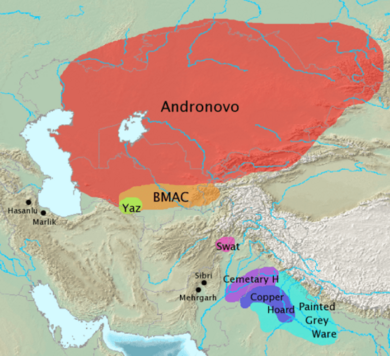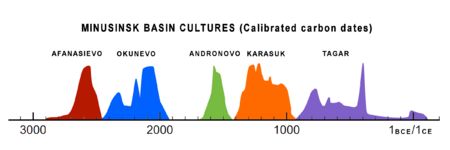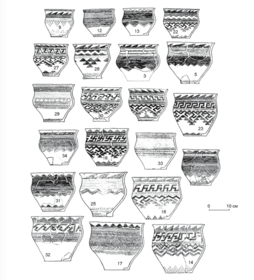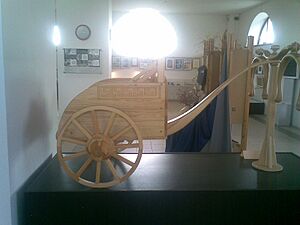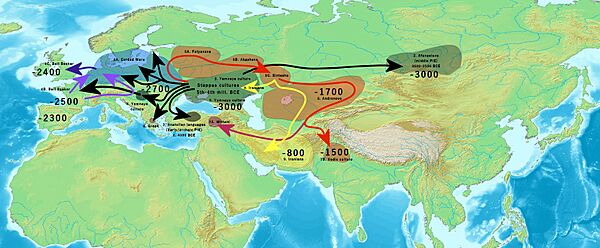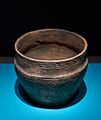Andronovo culture facts for kids
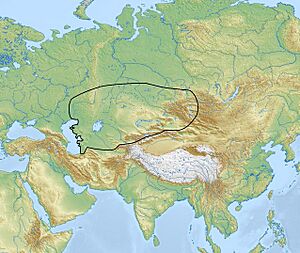 |
|
| Geographical range | Eurasian steppe |
|---|---|
| Period | Late Bronze Age |
| Dates | c. 2000 BC – 1150 BC |
| Preceded by | Kelteminar culture, Sintashta culture, Okunev culture, Seima-Turbino phenomenon |
| Followed by | Karasuk culture, Begazy–Dandybai culture, Tasmola culture |
The Andronovo culture was a group of similar cultures that existed during the late Bronze Age, from about 2000 BC to 1150 BC. These cultures were found across a huge area, stretching from the southern Ural Mountains all the way to the upper Yenisei River in central Siberia.
Some experts call it an "archaeological complex" because it includes several related cultures. The slightly older Sintashta culture (around 2200–1900 BC) used to be considered part of Andronovo, but now it's seen as a separate, earlier group. The Andronovo culture likely started around 2000 BC, with people raising cattle. There was plenty of food for animals in the pastures near their homes.
Most researchers believe the Andronovo culture is linked to early Indo-Iranian languages. However, it might have also been near areas where early Uralic and Yeniseian languages were spoken. Genetic studies suggest that the Andronovo and Sintashta cultures partly came from the Corded Ware culture in Europe.
Contents
How was the Andronovo Culture Discovered?
The name "Andronovo" comes from a village in Siberia called Andronovo. In 1914, a Russian zoologist named Arkadi Tugarinov found the first remains there. He discovered several graves with skeletons buried in a crouched position, along with beautifully decorated pottery. The Andronovo culture was first officially identified by the Russian archaeologist Sergei Teploukhov in the 1920s.
What are the Main Andronovo Groups?
The culture of Sarazm (4th–3rd millennium BC) existed before the Andronovo steppe culture arrived in South Central Asia.
Today, experts mainly recognize two main groups, or "sub-cultures," within the Andronovo culture:
- Alakul (2000–1700 BC): Found between the Amu Darya and Syr Darya rivers, and in the Kyzylkum Desert.
- Fëdorovo (2000–1450 BC): Located in southern Siberia. This group shows the earliest signs of cremation (burning the dead) and a fire cult.
Other researchers used to include more groups as part of Andronovo, such as Eastern Fedorovo and Alekseyevka-Sargary. However, new discoveries are always changing how we understand these ancient cultures.
Where did the Andronovo Culture Live?
The Andronovo culture covered a huge area, so it's hard to draw exact borders. To the west, it was near the Srubna culture. To the east, it reached the Minusinsk depression. Some sites were found as far south as the Kopet Dag mountains in Turkmenistan and the Tian Shan mountains in Kyrgyzstan. The northern border was roughly where the Taiga forests began.
Recently, signs of the Andronovo culture have also been found in Xinjiang, a region in far-western China. In the Volga river area, the Andronovo people had a lot of contact with the Srubna culture.
The Andronovo culture spread eastward over time. In its later stages, it reached the Upper Yenisei River, taking over from the Okunev culture. In southern Siberia and Kazakhstan, the Karasuk culture (1500–800 BC) followed the Andronovo culture.
Later, groups like the Cimmerians and Saka (also known as Scythians) appeared in this area. These groups are mentioned in ancient records and are believed to have migrated into Ukraine and across the Caucasus mountains.
What was Life Like in the Andronovo Culture?
The Andronovo culture included both groups of people who moved around a lot and those who lived in settled villages. Many settlements were found in Central Asia. Some villages had defenses like ditches, earth walls, and wooden fences. About twenty such fortified villages have been found.
Andronovo villages usually had 2 to 20 houses, but some large settlements had as many as 100 houses. Their homes were typically made from pine, cedar, or birch wood. They were often built overlooking riverbanks. Larger homes were 80 to 300 square meters in size. These big houses probably belonged to extended families, which was common among early Indo-Iranians.
Animals and Farming
The Andronovo people raised cattle, horses, sheep, goats, and even camels. They did not raise pigs, which is typical for people who move around a lot. They had more cattle than their western neighbors, the Srubna people.
Horses were very important. They were used for riding and pulling things. In 2020, scientists studied two ancient horses from an Andronovo burial site. They found that the Andronovo people were riding horses much earlier than many researchers thought. The horses were buried with their owners, showing how important they were. They were used for food, pulling vehicles, and riding. Farming was not a major part of the Andronovo economy.
Metalworking Skills
The Andronovo culture was very good at working with metals. They mined copper ore in the Altai Mountains from about the 14th century BC. They made many Bronze objects, and they had workshops for working with copper.
Unique Pottery
One special feature of the Andronovo culture is its pottery. This pottery is called Incised Coarse Ware (ICW). It was handmade, grey to brown in color, and decorated with geometric patterns. This type of pottery was found across a large area, from the Southern Urals to Kashgar. It was made by nomads during the late Bronze Age.
Warfare and Leaders
It is believed that the leaders of the Andronovo people were skilled riders and fighters. Their power might have come from their ability to control their own people and neighbors. A rider has a big advantage over someone fighting on foot. Another idea is that these leaders helped solve problems within their communities. This gave them power and high social status. Some call them the "Sheriffs of the Bronze Age."
Burial Customs
The Andronovo people buried their dead in chambers made of timber or stone. These chambers were placed under round or rectangular mounds called kurgans. Along with the dead, they buried animals, wheeled vehicles, horse gear, weapons, pottery, and ornaments.
One of the most interesting finds is the burial of chariots, dating back to around 2000 BC. These chariots were found with pairs of horses. They also had a special ritual where only the head and hooves of a horse were buried. Some Andronovo people were buried in pairs, either two adults or an adult and a child.
At a site called Kytmanovo in Russia, scientists found a type of ancient bacteria in a woman's tooth. This bacteria was similar to the one that causes plague, but it was weaker. The three people in that grave died at the same time, and researchers think this illness might have caused their deaths.
Andronovo People and Languages
Most experts agree that the Andronovo culture was linked to the Indo-Iranian languages. They are believed to have invented the spoke-wheeled chariot around 2000 BC. The oldest known chariots were found in the Sintashta culture, which is an early part of the Andronovo period.
The connection between the Andronovo culture and Indo-Iranians is supported by the names of places in the region. Also, later groups like the Saka (Scythians), Sarmatians, and Alans, who spoke Iranian languages, lived in the same area.
The Sintashta site is famous for its chariot burials and mounds containing horse burials. It's thought that the language spoken there was an early form of Proto-Indo-Iranian.
Experts often compare what they find from the Andronovo culture with ancient texts like the Vedas and the Avesta. These texts are important for understanding the Indo-Iranian identity of the Andronovo people. It's believed that the Andronovo culture spread south into Central Asia, bringing their language with them. While the early Andronovo culture might have spoken a very early form of Indo-Iranian, later groups likely spoke a branch of Iranian languages.
The chariot is a key piece of evidence. It was used by Indo-Aryans in ancient kingdoms like Mitanni and in Vedic India. Since it wasn't found in the Near East or Harappan India before, and it appeared at the Andronovo site of Sintashta around the 17th–16th century BC, it helps link Andronovo to the Indo-Iranians.
Some researchers have suggested that the Andronovo people spoke a unique branch of Indo-Iranian. They point to words borrowed into Finno-Ugric languages as proof. Other researchers think these borrowed words show the language was specifically like early Indo-Aryan.
It's possible that other languages were also spoken in parts of the Andronovo area, as old Indo-Iranian words were borrowed into Uralic and Proto-Yeniseian languages.
What did the Andronovo People Look Like?
Studies from the mid-2000s described the Andronovo people as having skull features similar to ancient and modern European populations. Their skulls were similar to those of the Srubnaya culture and Sintashta culture. Through migrations, this physical type spread south and mixed with local people, helping to form the populations of modern India.
Genetic Studies of the Andronovo People
Genetic studies show that the Andronovo culture and its people mainly came from an eastward spread of the Central European Corded Ware culture. This happened through the Fatyanovo–Balanovo and Sintashta culture groups. These groups had a mix of ancestry from the Yamnaya culture and early European farmers. The spread of Sintashta-Andronovo genes is linked to the spread of Indo-Iranian-speaking peoples.
Research Findings
- 2004 Study: Researchers found that during the Bronze and Iron Ages, most people in Kazakhstan (part of the Andronovo culture) had genes from West Eurasia. Before the 13th to 7th centuries BC, all samples from Kazakhstan were of European origin.
- 2009 Study: This study looked at ten individuals from the Andronovo culture in southern Siberia (1800 BC to 1400 BC). Most of them (78%) had European ancestry, with light skin, light eyes, and light hair. Only two (22%) had Asian ancestry. One male was found to belong to a Y-DNA group called Haplogroup R1a1a, which is linked to the eastward movement of early Indo-Europeans.
- 2015 Study: This study found that the Andronovo people were genetically very similar to the earlier Sintashta culture. The Sintashta culture, in turn, was closely related to the Corded Ware culture. This suggests that the Sintashta culture was an eastward expansion of the Corded Ware people. Many cultural similarities have been found between the Sintashta/Andronovo culture, the Nordic Bronze Age, and the people described in the Rigveda.
- 2018 Study: The remains of an Andronovo female from around 1200 BC were examined. She carried a maternal haplogroup called U2e1h.
- 2019 Study: A large number of remains from the Andronovo culture were studied. Most of the Y-DNA belonged to R1a1a1b or its subgroups. Most of the mtDNA samples belonged to U. The Andronovo people were found to be closely related to the people of the Corded Ware culture, Potapovka culture, Sintashta culture, and Srubnaya culture. These groups had mixed ancestry from the Yamnaya culture and people from Central Europe. People in the northwestern Andronovo areas were "genetically almost indistinguishable" from Sintashta people. This suggests that the Andronovo culture came from Central European people moving back into the steppe.
- 2022 Study: Researchers estimated that the genetic features typical of the Andronovo culture's people formed around 2900 BCE, about 900 years before the archaeological culture itself appeared.
Images for kids
See also
- Aryan
- Multi-cordoned ware culture
- Abashevo culture
- Prehistory of Siberia
- Tazabagyab culture


